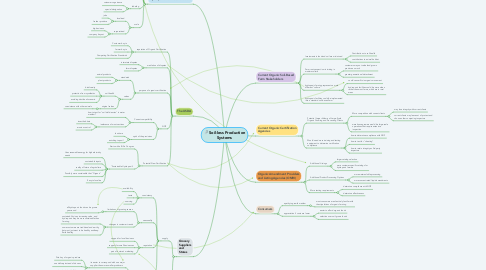
1. Current Organic Soil-Based Farm Stakeholders
1.1. Investments in land and soil are minimized
1.1.1. Contributions to soil health
1.1.2. contributions to animal habitat
1.2. Farm roots aspect is minimizing in modern culture
1.2.1. customers may not value land-grown produce as much
1.2.2. greater generational detachment
1.3. hydroponic farming represents a much different "culture"
1.3.1. could cause rifts in organic movement
1.3.2. hydroponic facilities could be more urban rather than most farms, which are in rural areas
1.4. hydroponic facilities could be implemented into a standard soil-based farm
2. Current Organic Certification Agencies
2.1. Potential Larger Volume of Large-Scale Organic Growing and Processing Clients
2.1.1. More competition with current clients
2.1.1.1. may lose integrity with current clients
2.1.1.2. current clients may leave out of protest and choose other competing inspectors
2.1.2. warehouse growers would be large-scale operations that require extensive inspection
2.2. Would need more training and testing equipment to determine certification compliance
2.2.1. how to determine compliance with NOP
2.2.2. how to test for "cheating"
2.2.3. how to retain integrity as 3rd party inspectors
3. Hydroponic Farm Stakeholders
3.1. higher market value
3.1.1. product placement
3.1.2. organic marketing
3.2. inputs
3.2.1. NOP-compliant
3.2.1.1. land-care regulation relevancy?
3.2.2. synthetics
3.2.2.1. how to test for deficiency?
3.3. stability
3.3.1. pathogens
3.3.2. consumer trends
3.4. labeling
3.4.1. customer cognizence
3.4.2. special designation
3.5. scale
3.5.1. localized
3.5.1.1. jobs
3.5.1.2. fresher produce
3.5.2. corporatized
3.5.2.1. big business
3.5.2.2. company buyout
4. The USDA
4.1. reputation of Organic Certification
4.1.1. Customer buy-in
4.1.2. farmer buy-in
4.1.3. Competing Certification Standards
4.2. mediation of disputes
4.2.1. inter-state disputes
4.2.2. farm disputes
4.3. purpose of organic certification
4.3.1. standards
4.3.1.1. animal products
4.3.1.2. plant products
4.3.2. values
4.3.2.1. soil-health
4.3.2.1.1. biodiversity
4.3.2.1.2. protection from sysnthetics
4.3.2.1.3. avoiding dust-bowl scenario
4.3.2.2. original values
4.3.2.2.1. coexistence with other animals
4.4. NOP
4.4.1. Current compatibility
4.4.1.1. how to test for "soil deficiencies" in water medium?
4.4.1.2. irrelevance of most sections
4.4.1.2.1. insect habitats
4.4.1.2.2. erosion control
4.4.2. spirit of the provisions
4.4.2.1. land care
4.4.2.2. enriching topsoil
4.5. Potential New Certification
4.5.1. Starts with a Bill in Congres
4.5.2. "Sustainable Hydroponic"
4.5.2.1. Uses renewable energy for high electricity needs
4.5.2.2. sustainable inputs
4.5.2.3. reality of future of agriculture
4.5.2.4. Possibly more sustainable that "Organic"
4.5.2.5. Easy to localize
5. Organic Amendment Providers and Listing Agencies (OMRI)
5.1. Additional Listings
5.1.1. larger catalog selection
5.1.2. more customer-specific catalogs for hydroponic farmers
5.2. Additional Product Processing Options
5.2.1. more water-soluble processing
5.2.2. more concentrated liquid amendments
5.3. More testing requirements
5.3.1. determine compliance with NOP
5.3.2. determine effectiveness
6. Grocery Suppliers and Stores
6.1. supply
6.1.1. consistency
6.1.1.1. availability
6.1.1.2. taste
6.1.1.3. sourcing
6.1.2. seasonality
6.1.2.1. limitations of growing season
6.1.2.1.1. all hydroponic foods can be grown year-round
6.1.2.2. changes in customer trends
6.1.2.2.1. sustainability is an increasing value, and hydroponic may be more sustainable than farming
6.1.2.2.2. some customers are traditional and earthy, but most just want to be healthy and keep Earth healthy
6.1.3. reputaiton
6.1.3.1. support for local business
6.1.3.2. support for small businesses
6.1.3.3. part of a store's marketing
6.1.4. ease of supply chain
6.1.4.1. its easier to correspond with one major supplier than more smaller producers
6.1.4.1.1. Frito-Lay of organic produce
6.1.4.1.2. one delivery instead of dozens
6.1.4.1.3. one invoice instead of dozens
6.1.4.2. fear of monopoly
6.1.4.2.1. one supplier could charge more and more without consequences
6.1.4.2.2. more suppliers have to lower prices to compete
6.2. marketing
6.2.1. ease of labeling if only one "organic" section and not two
6.2.2. low-priced organic foods will excite more customers
7. Consumers
7.1. apathy to growth medium
7.1.1. most consumers aren't entirely familiar with the stipulations of organic farming
7.2. appreciation if costs are lower
7.2.1. easier to afford organic foods
7.2.2. selection over soil-grown foods
